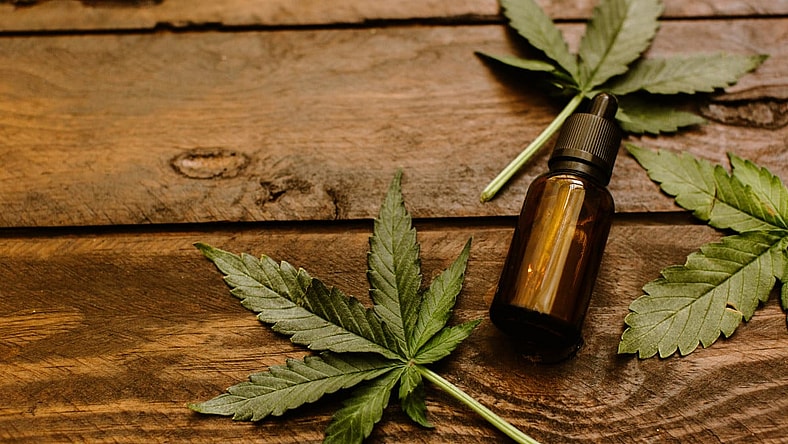CBD 101: Everything You Need to Know about The Hottest Trend In Cannabis
Here’s what you need to know about everyone’s new favorite miracle drug.


Cannabidiol, or CBD, is one of the main compounds of marijuana and its use is one of the most popular trends in the health and wellness scene thanks to its numerous health benefits.
It’s been shown to be an effective treatment for conditions like anxiety, inflammation, depression, seizures, nausea, pain, spasms, arthritis, and symptoms of multiple sclerosis, among others.
It’s usually consumed in oils, drinks, edibles, and topically in the form of creams and balms, and—perhaps most importantly for some people—unlike THC, it won’t get you high.
To really learn the ins and outs of CBD and how to use it properly, we spoke to Dr. Josh Axe, a doctor of natural medicine, chiropractor, clinical nutritionist, and overall health expert who also founded Ancient Nutrition and wrote the bestselling book Keto Diet.
The difference between CBD and THC:
You already know this if you’ve ever smoked weed, but “the major difference between the two compounds is that CBD is a non-intoxicating compound that will not leave you feeling high. THC, on the other hand, does have intoxicating and euphoric effects, especially when it’s taken in higher doses,” Dr. Axe explains.
Here’s how it works:
According to Dr. Axe, “Both CBD and THC are found in the ancient plant Cannabis sativa, and both interact with receptors in the Endocannabinoid System, a biochemical communication system that was only discovered about 25 years ago. Overall, this system works to keep the body in homeostasis.
“CBD interacts with cannabinoid receptors (called CB1 and CB2) throughout the body, including the central nervous system and immune system. These receptors influence the body’s ability to function properly by producing effects within our cells.”
In other words, CBD seems to be very important and effective at maintaining balance between interdependent elements in the body and acts as a mediator when things start to go haywire.
For example, a study found that CBD is extremely effective at balancing and lowering the stress hormone cortisol. This is important—we all know how toxic stress can be.
Finding the perfect dose:
Something to keep in mind is that unlike pharmaceuticals, there hasn’t been enough clinical research on CBD to fully determine exact dosing guidelines.
Dr. Axe says, “There’s no official serving size for CBD. Everyone is different, with some people being more sensitive than others.
“You’ll typically want to start with a lower dose of 5-10 milligrams, or what your healthcare professional suggests. Give your starting dose 5-7 days and track whether or not they meet your original goals. If you haven’t noticed steps towards meeting your goals, try increasing your dose by about 5 milligrams and try that for another 5-7 days.”
What to avoid:
CBD might interfere with certain routinely prescribed drugs, so it’s always best to check with your doctor before adding it to your daily routine.
“CBD is a potent inhibitor of CYP450 enzymes, which work to metabolize prescription drugs and eliminate toxins from the body. This means that using CBD while taking prescription medications may alter the body’s ability to metabolize or break down the drug.”
Ultimately Dr. Axe recommends steering clear of mixing those prescriptions with CBD as they may have adverse interactions. “Any medication that’s metabolized by CYP450 enzymes shouldn’t be taken with CBD.”
Different types of CBD products and how to take them:
With so many different types of CBD products, it can be confusing to get exactly what you want. Oils, tinctures, gummies, vapes…what’s the difference, and which is the best way to take CBD?
Dr. Axe recommends “a high-quality, organic, full spectrum CBD oil that’s been third party lab tested and tested to contain no contaminants. Oil is the least processed form of CBD, usually made with CO2 extraction. Oils are whole-plant extracts that typically include other cannabinoid compounds, terpenes and essential oils.”
Tinctures are slightly more processed, and is CBD that’s been extracted with alcohol or another similar solvent.
“One of the most popular ways to use CBD oil is by placing it under the tongue and swallowing. You simply place the oil under the tongue, let it sit for about 15 seconds and swallow. This can be done with tinctures too.”
When oils and tinctures are taken sublingually, effects can be felt within minutes (generally 15) as it enters your bloodstream quickly from under the tongue.
Most gummies and other edibles are typically made from an isolation of the CBD compound, a.k.a. pure CBD — unlike oils, which are made from the entire hemp plant. The effects of edibles won’t set in for about 30 to 90 minutes.
Lastly, vaping is the fastest way to get CBD into your bloodstream through your lungs, and effects are felt almost immediately.
“CBD is also available as capsules, powders, lotions and patches,” Axe concludes. “All of these methods are considered appropriate means of consuming CBD as long as you are using a high-quality product from a reputable company.”
To elaborate, CBD is sold as a supplement and not a medication, so the FDA isn’t able to regulate its purity. That means not everything you see on the market is actually good for you.
“Overall, it’s best to avoid synthetic ingredients and other additives. You want to choose an organic product, preferably made in the U.S., that’s third-party lab tested.”
For more information on cannabidiol, check out Rave Reviews’ guide to the Best CBD Oil.
